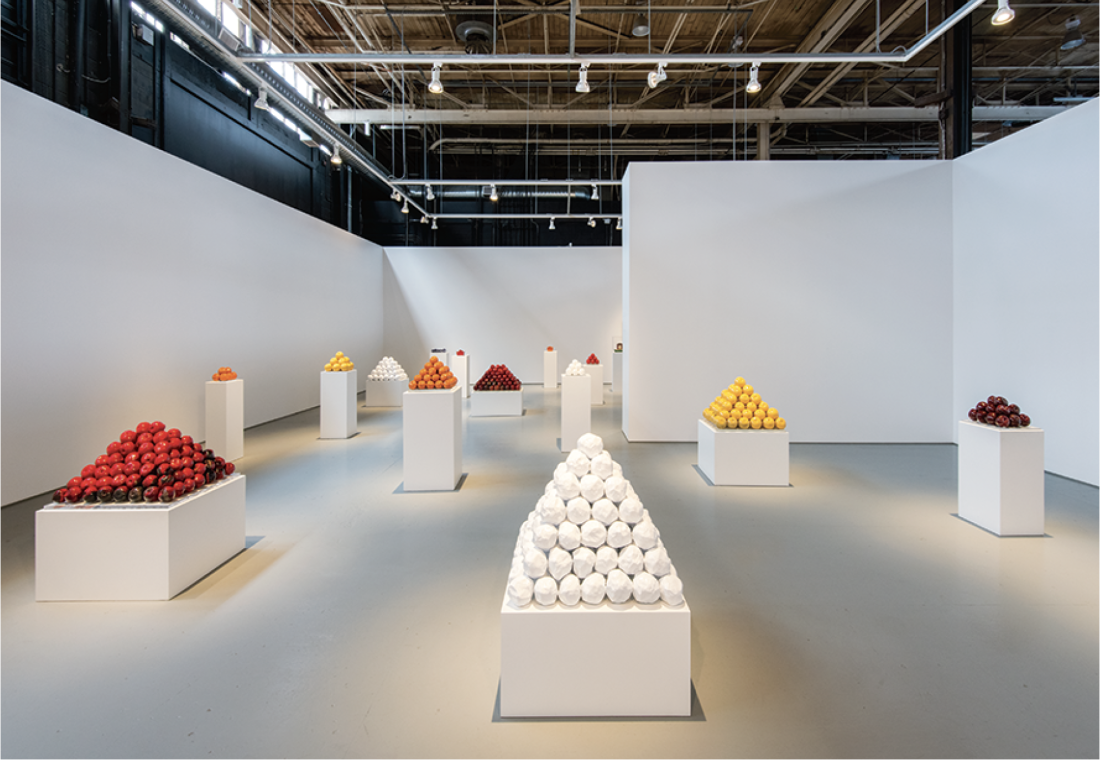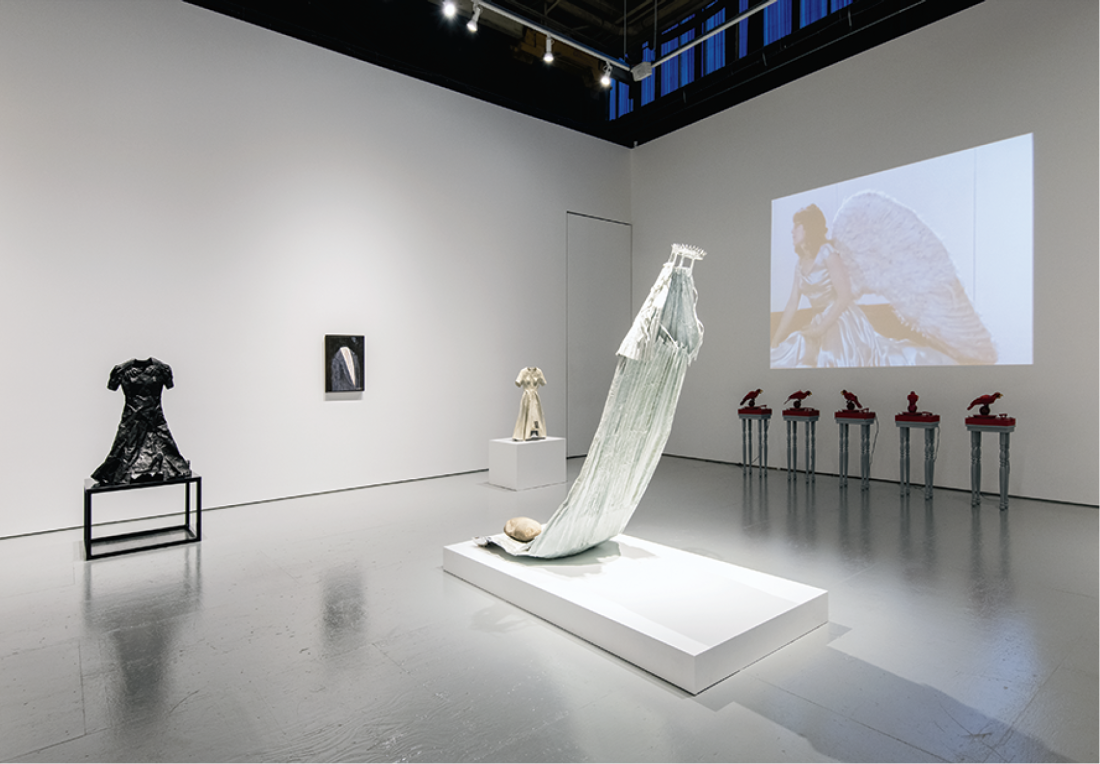Gathie Falk
In 2013, when Gathie Falk was awarded the Audain Prize for Lifetime Achievement, she told the audience she hoped this honour didn’t suggest her career was over. Her delivery was funny but firm. Her mind, she said, was constantly being replenished with images and ideas; there were many more “things” in her head that she had yet to realize in her art.
Falk is famous for imaginatively transforming the most banal particulars—from concrete sidewalks and cedar hedges to snowballs, baseball caps and men’s shoes—into visually and emotionally compelling art. Her practice has cycled through changes of style, dimension, material and scale, from small, neo-expressionist still lifes in oil to room-sized, mixed-media installations, and from large, lyrical abstractions to surreal, tabletop tableaux in glazed and painted ceramic. Although her art is largely representational, it has always skewed expressively away from the naturalistic. There has also been a conceptual aspect to her practice. Early on, she created acclaimed performances; much later, she experimented with a wall-sized grid of identical black-and-white photographs. Just as her materials may vary from the heroic, such as cast bronze, to the humble, such as papier-mâché, the mood may also shift, from sunny to spooky, direct to mysterious, playful to profound. Irrespective of formal or material strategies, Falk’s overarching themes have remained consistent. Behind the unpretentious beauty of the everyday is the spectre of death. Behind the depiction of life in glorious bloom is the shadow of decay and dissolution. And behind every affirmation of communion and connection is the certain knowledge of loss.
Falk is something of a folk hero in Vancouver and the opening of her retrospective exhibition at the Equinox Gallery, on a day of pelting rain, attracted hundreds of visitors. Return visits reinforced the impression that “The Things in My Head,” which selectively surveyed Falk’s two- and three-dimensional art from 1962 to 2015, was beautifully curated and installed. The show attested to the artist’s idiosyncratic vision and enduring energy, while smartly juxtaposing recurring images, motifs and formal devices. It also spoke to the willingness of Falk’s dealer to exhibit a number of works that were not offered for sale but that had been borrowed from private and corporate collections across the country. This proved to be a canny move, providing thematic continuity and contextual depth to the art, old and new, that was available for purchase. The show included examples of Falk’s subtle, Agnes Martin-esque Shirting paintings on vellum, a gorgeous array of ceramic fruit, a celestial canoe sculpted out of papier-mâché, covered with aluminum paint and adorned with coloured ribbons, six marvellous “Bootcases” (ceramic sculptures of men’s right shoes, mounted in glass-fronted wooden cabinets), a couple of examples of women’s dresses in bronze and papier-mâché, and a recent series of men’s shirts cast in polymerized gypsum.

Gathie Falk, installation view, “The Things in My Head,” 2015, Equinox Gallery, Vancouver. Photograph: Site Photography. Courtesy Equinox Gallery.
The first artwork, in the gallery’s lobby, was My Dog’s Bones, originally created in 1985 but still, all these years later, completely surprising in its combinations of forms and materials. The installation consists of hundreds of animal bones (of the kind a dog would chew on), hanging by strings from a ceiling grid and suspended above another grid, this one consisting of 16 little spruce trees sitting in pots and arranged in four rows of four. The trees, pots and bones cast shadows, both actual and painted, across the floor and up the wall, merging the real and the surreal, the physical and the metaphysical, in a dappled cloud of dull and shiny greys. As Falk has done so poetically and uniquely throughout her career, she seemed in this installation to be staging an existential drama of the colloquial and the quirky, the living and the dead, in a manner that could only have emerged from her imagination and no one else’s.
The most dazzling gallery was filled with luscious, pyramidal piles of ceramic fruit—apples, oranges, grapefruit—created nearly three decades ago and among the most beloved works Falk has produced. These were displayed with more recent pyramids of powder-coated bronze “snowballs.” As if to prove my life-death thesis, the brilliant colours and voluptuous shapes of the fruit stood in dramatic opposition to the snowballs. Titled “Arsenal” and dating between 2012 and 2015, the latter series clearly signifies weapons and the ways in which children’s games foretell adult aggression. And although Falk is interested in personal rather than universal symbols, the pyramidal shape of all the piles—fruit and snowballs—iterates its own ancient history of royal burials and human sacrifice.
Still-life paintings produced in 1962, 2009 and 2015 were exhibited alongside three-dimensional still lifes in glazed and painted ceramic, created in the late 1960s and early 1970s. These included selections from Falk’s “Picnic” series of ceramic tableaux, such as 1973’s Picnic with Clock and Bird. Here, a black bird is depicted lying lifelessly atop a red mantel clock, itself set on a decorative white “cloth” spread over a rectangle of green “grass.” The entire work is as direct and at the same time as surreal a memento mori as Falk has ever produced.
In the late 1970s, Falk surprised many by moving from the ceramic sculptures and performance works which had launched her career to (seemingly) abstract paintings on canvas. That shift was represented in the exhibition by eight big paintings from the 1982 series “Pieces of Water.” Based on her unusual idea of taking a “long sharp knife” and carving out a geometric piece of the ocean, these works are reminiscent of the more abstract passages in Claude Monet’s “Water Lilies.” They are slightly suggestive too of Gershon Iskowitz’s late paintings. (Such likenesses were not consciously intended by the artist.) The mark-making is deft, meant not as a literal representation of waves and ripples and the play of light across the water’s surface, but rather to convey, in abstract-expressionist fashion, Falk’s emotional response to her subject. The palette is eloquent, shifting from painting to painting, compassing pale and mossy greens through violet and lavender, aquamarine and azure, pale greys and yellows, and frothy white—with occasional bloody splatters of cadmium red.

Gathie Falk, installation view, “The Things in My Head,” 2015, Equinox Gallery, Vancouver. Photograph: Site Photography. Courtesy Equinox Gallery.
One of the strongest juxtapositions in the show was the installation of Falk’s 2010–2011 sculpture The Problem with Wedding Veils adjacent to a video projection of and props from her 1972 performance Red Angel. In the latter, Falk poses atop a red-painted wooden dresser while wearing a large pair of feathered wings and an old-fashioned, long-sleeved wedding dress. Five identical fake parrots spin on five turntables at the front of the action, all their components delivered, again, in brilliant red. Falk sheds the wedding dress and a fellow performer picks it up, launders it in a creaky old ringer washing machine and hangs it to dry. Throughout the protracted performance, all executed wordlessly except for a brief round of “Row, Row, Row Your Boat” sung by an unseen chorus offstage, Falk remains as still and silent as a marble statue. She has shed a potent symbol of married life—the ritual enacted here is a literal cleansing—but at no stage does the performance appear to be cathartic.
Six feet tall, leaning forward at an unsettling angle, its crown-like headdress fiercely spiked and its long train weighted down by two big rocks, The Problem with Wedding Veils reads as an even more sinister indictment of marriage. The papier-mâché has been painstakingly pleated and evocatively painted, and yet the impression the work gives is one of Gothic horror. There’s the sense here of an unhappy ghost, eternally burdened with both longing and regret.
The only disappointment in the show was Falk’s new series of men’s shirts, based on a hand-sculpted, papier-mâché original. Collectively titled “Tom,” cast in polymerized gypsum and painted with acrylics, these works did not achieve the nuanced individuality of the artist’s earlier series of papier-mâché men’s shirts, “Portraits,” created in 2000. The overall form of the new works was consistent with the earlier series, which addressed ideas of gendered identity and the semiotics of fashion, but the patterning and surface treatment were dull and generic rather than individualistic, deadpan rather than emotive. This was curious, because the bronze casts of a series of papier-mâché dresses that Falk had earlier produced are immensely engaging, despite the profound shift in material and palette.
Still, it’s a minor criticism of a dazzling show, so smartly representative of Falk’s richly prolific career and her particular melding of keen observation with surreal imagination. ❚
“The Things in My Head” was exhibited at Equinox Gallery, Vancouver, from November 7 to December 19, 2015.
Robin Laurence is a Vancouver-based writer, curator and contributing editor to Border Crossings.

